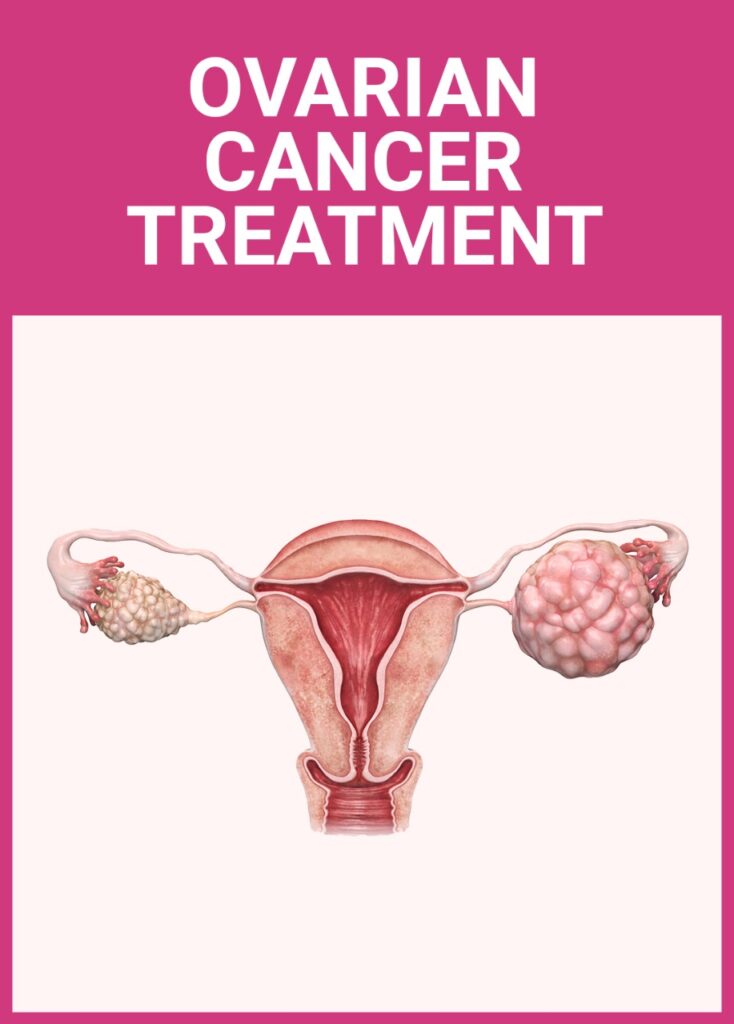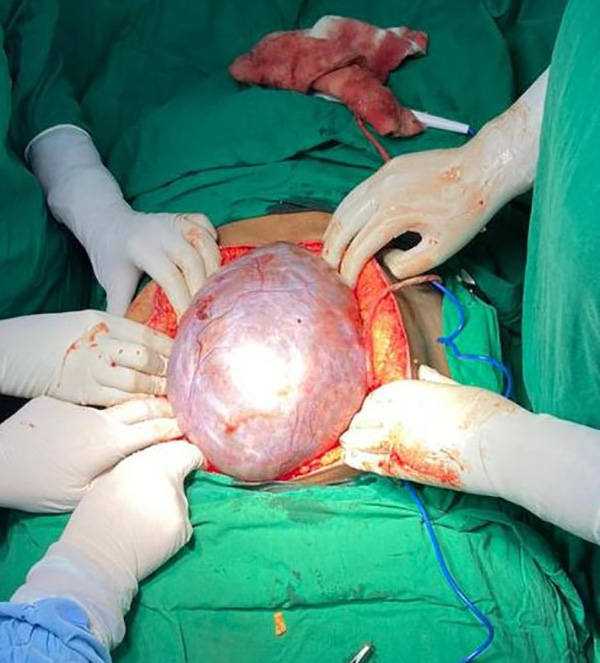
What is Ovarian Cancer?

What is Ovarian Cancer?
Ovarian cancer is a type of cancer that begins in the ovaries. The female reproductive system contains two ovaries, one on each side of the uterus. The ovaries – each about the size of an almond – produce eggs (ova) as well as the hormones estrogen and progesterone.
Ovarian cancer is when abnormal cells in the ovary begin to multiply out of control and form a tumor. Some tumors are benign (non-cancerous). Others are malignant (cancerous.) Ovarian tumors may be either solid or cystic (fluid-filled sacs). They can look very similar in appearance to benign ovarian cysts, which are very common, and this can make early diagnosis difficult.
If left untreated, the tumor can spread to other parts of the body. This is called metastatic ovarian cancer. Ovarian cancer often has warning signs, but the earliest symptoms are vague and easy to dismiss. Hence only 20% of ovarian cancers are detected at an early stage and majority are diagnosed in advanced stage of the disease.
Is ovarian cancer deadly?
Ovarian cancer is considered to be the deadliest among all gynaecological cancers. There are no specific symptoms that can help in diagnosing ovarian cancer early. Symptoms often develop late, when the cancer is already advanced, and hence ovarian cancer has been called the “silent killer” or “the cancer that whispers.” Survival rates for ovarian cancer vary depending on many different factors, including the age of the woman, the stage of ovarian cancer at the time of diagnosis and the type of treatment received.
What are the stages of ovarian cancer?
Staging is the process of finding out how much cancer is in a person’s body and where it’s located or how much it has spread.
- Stage I: Cancer is found in one or both ovaries.
- Only 15% of all cases of ovarian cancer are diagnosed when they are Stage I.
- Stage II: Cancer is found in one or both ovaries and has spread into other areas of the pelvis.
- Stage II ovarian cancer is a small group, compromising 10% of ovarian cancer diagnoses.
- Stage III: Cancer is found in one or both ovaries and has spread outside the pelvis to other parts of the abdomen and/or nearby lymph nodes. Cancer that has spread to the surface of the liver is also considered stage III ovarian cancer.
- 60% of all cases of ovarian cancer are diagnosed when they are Stage III.
- Stage IV: In stage IV, cancer has spread beyond the abdomen to other parts of the body, such as the lungs or tissue inside the liver. Cancer cells in the fluid around the lungs is also considered stage IV ovarian cancer.
- 15% of all ovarian cancer cases are diagnosed in stage IV.

How fast does ovarian cancer grow?
- Ovarian cancer grows quickly and can progress from early to advanced stages within a year. It has been scientifically studied that ovarian cancer canprogress from stage to stage in a matter of months, making it far more aggressive than malignancies such as breast cancer.
- Paying attention to symptoms can help improve a woman’s chances of being diagnosed and treated promptly. Detecting cancer while it is still in its earliest stages may help improve prognosis.
What are the symptoms of ovarian cancer?
- Ovarian cancer is commonly thought to be a silent killer or the cancer that whispers. This is because early stage ovarian cancers have almost none or very minimal symptoms.
- Small ovarian tumors are often without any symptoms and are usually discovered incidentally during investigations for other conditions.
- A larger ovarian tumor can cause genitourinary symptoms, including urinary frequency, and dyspareunia. Sometimes ovarian masses can cause bowel symptoms like constipation. These symptoms can occur in both benign disease and early ovarian cancer. It is impossible to differentiate a benign from a malignant ovarian mass by clinical examination alone.
- An ovarian mass can sometimes cause sudden onset of abdominal pain and can become a surgical emergency. This can be due to rupture, torsion, and possible hemorrhage (bleeding) inside a cyst, which distends it, or by the rupture of a blood-filled cyst, causing hemoperitoneum.
- Symptoms of advanced ovarian cancer are more varied. These can be fatigue, early satiety, and loss of appetite. Sometimes there may be bloating and diffuse, dull, constant abdominal pain.

What are the signs of late stages of ovarian cancer?
- The clinical presentation of advanced ovarian cancer is varied. Treating doctors are often surprised by how few symptoms women with advanced ovarian cancer may experience. Nonspecific symptoms associated with advanced ovarian cancer include anorexia, fatigue, nausea, belching, early satiety, and loss of appetite.
- Often patients may have bloating and diffuse, dull, constant abdominal pain, changes in the frequency of bowel movements, with alternating constipation and diarrhea.
- Sometimes, patients with advanced ovarian cancer present with deep venous thrombosis (DVT) i.e formation of blood clots in the deep vein of legs and lower abdomen which leads to swelling of one or both legs. DVT occurs due to large tumors pressing on pelvic veins or as part of the hypercoaguable state which is increased tendency to form blood clots associated with advanced-stage cancer.
Causes and risk factors of ovarian cance
- About 20% of high-grade ovarian cancers arise in women who carry heritable germline mutations in cancer susceptibility genes—predominantly BRCA1 or BRCA2. These women have Hereditary ovarian cancer where multiple female relatives suffer from Breast and Ovarian cancer.
- The rest majority of ovarian cancer is sporadic and arises due to accumulation of somatic genetic mutations.
There are many risk factors which increase the risk of having ovarian cancer.
- Age – Older women have a higher risk for ovarian cancer than younger women. Ovarian cancer usually occurs after menopause, although it can develop in women of all ages. Most women diagnosed with ovarian cancer are older than age 55.
- Family History – Women are at high risk for ovarian cancer and for harboring a genetic mutation such as BRCA if they have a family history of breast and ovarian cancer in close relatives.
- Genetic Mutations – Inherited mutations in the genes called BRCA1 and BRCA2 greatly increase the risk for ovarian and breast cancers.Women with a BRCA1 mutation have about a 44% lifetime risk for ovarian cancer. Women with a BRCA2 mutation have about a 17% lifetime risk for ovarian cancer. (By contrast, the lifetime ovarian cancer risk for women in the general public is about 1 in 55 or 1.3%.)These gene mutations are also associated with increased risks for breast cancer, fallopian tube cancer, pancreatic cancer, and prostate cancer in the male.In addition to an increased lifetime risk, women with these gene mutations tend to develop these cancers at an earlier age than that seen in the usual population of women with ovarian cancer.Other genetic factors are also associated with increased risk. Women who have genetic mutations associated with hereditary non-polyposis colorectal cancer (HNPCC or Lynch syndrome) have about a 10% to 15% lifetime risk of developing ovarian cancer.
- Personal Medical History – Women who have been diagnosed with breast cancer are at increased risk for ovarian cancer, even if they do not have BRCA mutations. Endometriosis, a condition in which the cells that line the cavity of the uterus grow in other areas of the body such as on the ovaries or on the other pelvic structures, increases the risk for ovarian cancer.

- Reproductive History – Women are at increased risk for ovarian cancer if they began menstruating at an early age (before age 12), have not had any children, had their first child after age 35, or experienced early menopause (before age 50). There are also preventive factors associated with reproductive history. The more times a woman gives birth, the less likely she is to develop ovarian cancer. Breast-feeding for a year or more after giving birth may also decrease ovarian cancer risk. Tubal ligation, a method of sterilization that ties off the fallopian tubes, is associated with a decreased risk for ovarian cancer. Similarly, hysterectomy, the surgical removal of the uterus, may decrease risk.
- Hormone Use – Women who use hormone therapy (HT) after menopause for longer than 5 years may have an increased risk for ovarian cancer. The risk seems to be particularly significant for women who take estrogen-only HT. The risk is less clear for combination estrogen-progestin HT. Oral contraceptives (birth control pills) significantly reduce the risk of ovarian cancer, in some series by as much as 50%. The longer a woman takes oral contraceptives the greater the protection and the longer protection lasts after stopping oral contraceptives.
- Obesity – Women who are obese have an increased risk for ovarian cancer.
What are the chances I have ovarian cancer?
The lifetime risk of ovarian cancer for women in the general public is about 1 in 55 or 1.3%.
Common Symptoms of Ovarian Cancer
Ovarian cancer does have symptoms, but they are often very subtle and easily mistaken for other, more common problems. In some rare cases, early stage ovarian cancers may produce symptoms, but in the majority of women these don’t show up until the cancer has advanced (when the growth of the tumor triggers symptoms). Several studies show that ovarian cancer can produce these symptoms:
- Bloating
- Pelvic or abdominal pain
- Difficulty eating or feeling full quickly
- Urinary symptoms like urgency (always feeling like you have to go ) or frequency (having to go often)
If you have these symptoms for more than two weeks, and the symptoms are new or unusual for you, see a Gynec Oncologist and ask about Ovarian Cancer.
Diagnosis of Ovarian Cancer
If a woman has the signs and symptoms of ovarian cancer, she needs a complete pelvic exam by a Gynec Oncosurgeon, a CT scan or MRI scan, and a CA-125 blood test.
The most important factors to be considered are the patient’s age, menopausal status, family history of any malignancy, clinical examination, and the results of blood levels of tumor markers i.e. CA-125 and imaging studies like CT or MRI scan.
Because of the lethality of ovarian cancer, it is considered advisable to “err on the side of caution.”
American College of Obstetrics and Gynecology (ACOG) and SGO consensus guidelines recommend referral to a gynecologic oncologist for women with elevated blood level of CA-125, presence of fluid in abdomen, an ovarian mass and evidence of abdominal/distant metastasis.
How ovarian cancer is diagnosed?
- If a woman has the signs and symptoms which suggest possibility of ovarian cancer, she needs a complete pelvic exam by a Gynec Oncosurgeon, a CT scan or MRI scan, and a CA-125 blood test.
- The most important factors to be considered to know a woman’s risk of ovarian cancer are, the patient’s age, menopausal status, family history of any malignancy, clinical examination, and the results of blood levels of tumor markers i.e. CA-125 and imaging studies like CT or MRI scan.
- Because of the lethality of ovarian cancer, it is considered advisable to “err on the side of caution.”
- If there is a suspicion from these tests that ovarian cancer might be present, the patient should seek a referral to a gynaecologic oncologist for Cytoreductive surgery and further treatment. Research shows that women treated by gynaecologic oncologists live longer than those treated by other physicians like general gynaecologists and general surgeons.
American College of Obstetrics and Gynecology (ACOG) and SGO consensus guidelines recommend referral to a gynecologic oncologist for women with elevated blood level of CA-125, presence of fluid in abdomen, an ovarian mass and evidence of abdominal/distant metastasis
Treatment options of ovarian cancer
- The standard treatment for ovarian cancer consists of debulking surgery followed by six cycles of chemotherapy.
- The most important prognostic factors predicting long-term survival from ovarian cancer are the FIGO stage and the amount of disease remaining after debulking surgery. Patients with ovarian cancer will benefit from treatment by a gynecologic oncologist or physicians familiar with the disease and skilled in its surgical management.
- Patients undergo chemotherapy in an effort to kill any cancer cells that remain in the body after surgery.
- A gynecologic oncologist is a specialist in treating women’s reproductive cancers. Women with ovarian cancer are strongly encouraged to seek care from one of these specialists.
- Multiple studies conducted over the past decade have shown that an ovarian cancer patient’s chance of survival is significantly improved when her surgery is performed by a gynecologic oncologist. One analysis of multiple studies found that women whose surgeries were performed by gynecologic oncologists had a median survival time that was 50 percent greater than women whose surgeries were done by general gynecologists or other surgeons inexperienced in optimal debulking procedures.
- Sometimes referred to as cytoreductive surgery, debulking involves removal of as much of the tumor as possible.
- Women whose tumors have been reduced to less than one centimeter have a better response to chemotherapy and improved survival rate.
Prevention of ovarian cancer
Most women have one or more risk factors for ovarian cancer. There are several ways to reduce one’s risk of developing ovarian cancer.
Some risk factors for ovarian cancer, like getting older or having a family history, cannot be changed. But women might be able to lower their risk slightly by avoiding other risk factors, for example, by staying at a healthy weight, or not taking hormone replacement therapy after menopause.
- Oral contraceptives- Using oral contraceptives (birth control pills) decreases the risk of developing ovarian cancer for average risk women and BRCA mutation carriers, especially among women who use them for several years. Women who used oral contraceptives for 5 or more years have about a 50% lower risk of developing ovarian cancer compared with women who never used oral contraceptives. Still, birth control pills do have some serious risks and side effects such as slightly increasing breast cancer risk. Women considering taking these drugs for any reason should first discuss the possible risks and benefits with their doctor.
- Gynecologic surgery- Both tubal ligation and hysterectomy may reduce the chance of developing certain types of ovarian cancer, but experts agree that these operations should only be done for valid medical reasons — not for their effect on ovarian cancer risk.
Prevention strategies for women with a family history of ovarian cancer or BRCA mutation
Oral contraceptives are one way that high risk women (women with BRCA1 and BRCA2 mutations) can reduce their risk of developing ovarian cancer.
Risk-reducing or prophylactic salpingo-oophorectomy (removal of both ovaries and fallopian tubes) is the standard recommendation for high-risk women after they have finished having children.
